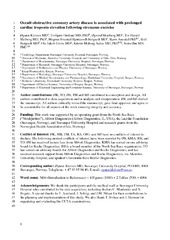| dc.contributor.author | Kleiven, Øyunn | en_US |
| dc.contributor.author | Omland, Torbjørn | en_US |
| dc.contributor.author | Skadberg, Øyvind | en_US |
| dc.contributor.author | Melberg, Tor Harald | en_US |
| dc.contributor.author | Bjørkavoll-Bergseth, Magnus | en_US |
| dc.contributor.author | Auestad, Bjørn Henrik | en_US |
| dc.contributor.author | Bergseth, Rolf | en_US |
| dc.contributor.author | Greve, Ole Jacob | en_US |
| dc.contributor.author | Aakre, Kristin Moberg | en_US |
| dc.contributor.author | Ørn, Stein | en_US |
| dc.date.accessioned | 2020-05-15T10:51:11Z | |
| dc.date.available | 2020-05-15T10:51:11Z | |
| dc.date.issued | 2019 | |
| dc.Published | Kleiven Ø, Omland T, Skadberg Ø, Melberg T, Bjørkavoll-Bergseth M, Auestad BH, Bergseth R, Greve OJ, Aakre A, Ørn S. Occult obstructive coronary artery disease is associated with prolonged cardiac troponin elevation following strenuous exercise. European Journal of Preventive Cardiology. 2019 | eng |
| dc.identifier.issn | 2047-4881 | |
| dc.identifier.issn | 2047-4873 | |
| dc.identifier.uri | https://hdl.handle.net/1956/22286 | |
| dc.description.abstract | Background: Sudden cardiac death among middle-aged recreational athletes is predominantly due to myocardial ischaemia. This study examined whether measuring cardiac troponin I and T (cTnI and cTnT) after strenuous exercise could identify occult obstructive coronary artery disease. Design: Prospective observational study. Methods: Subjects were recruited from 1002 asymptomatic recreational cyclists completing a 91-km mountain bike race (North Sea Race Endurance Exercise Study). No subject had known cardiovascular disease or took cardiovascular medication. Blood samples were collected within 24 h before and 3 h and 24 h after the race. Coronary computed tomography angiography was performed in 80 participants with the highest post-exercise cTnI and in 40 reference subjects with moderately elevated cTnI values. Results: Study subjects (N = 120) were 45 (36–52) years old and 74% were male. There were similar demographics in the High-cTnI group and the Reference group. The cTn concentrations were highest at 3 h post-race: cTnI, 224 (125–304) ng/L; cTnT, 89 (55–124) ng/L. Nine subjects had obstructive coronary artery disease on coronary computed tomography angiography, eight of whom were High-cTnI responders. Two subjects had myocardial bridging, both High-cTnI responders. Troponin concentrations at 24 h post-race were higher in subjects with obstructive coronary artery disease than in the rest of the cohort (n = 109): cTnI, 151 (72–233) ng/L vs. 24 (19–82) ng/L, p = 0.005; cTnT, 39 (25–55) ng/L vs. 20 (14–31) ng/L, p = 0.002. The areas under the receiver operating characteristic curves for predicting obstructive coronary artery disease were 0.79, p = 0.005 (cTnI) and 0.82, p = 0.002 (cTnT). Conclusion: In subjects with occult obstructive coronary artery disease there was a prolonged elevation of cTn following strenuous exercise. | en_US |
| dc.language.iso | eng | eng |
| dc.publisher | Sage | eng |
| dc.title | Occult obstructive coronary artery disease is associated with prolonged cardiac troponin elevation following strenuous exercise | en_US |
| dc.type | Peer reviewed | |
| dc.type | Journal article | |
| dc.date.updated | 2019-12-09T08:19:59Z | |
| dc.description.version | acceptedVersion | en_US |
| dc.rights.holder | Copyright The European Society of Cardiology 2019 | |
| dc.identifier.doi | https://doi.org/10.1177/2047487319852808 | |
| dc.identifier.cristin | 1713798 | |
| dc.source.journal | European Journal of Preventive Cardiology | |
